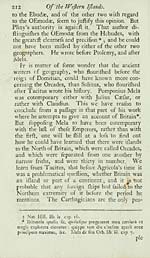Blair Collection > Critical dissertations on the origin, antiquities, language, government, manners, and religion, of the antient Caledonians, their posterity the Picts, and the British and Irish Scots
(249)
Download files
Complete book:
Individual page:
Thumbnail gallery: Grid view | List view

[Of the Wejiern IJlands. 2 1 1
refpeift with much freedom. Some eminent cri-
tics have obferved, that this author copies, in a
fervile manner, after Pliny the elder ; but he has
rejeded his authority with regard to the number
of the Ebudes and of the Orkney ifles. Accord'
ing to Pliny*, the Orcades amount to forty, and
the Hebrides to thirty ; but Solinus reduced the
number of the Hebrides to five, and of the Or-
cades to three wretched ifles, overgrown with
rufhes, or made up of horrible rocks or naked
fands, and totally deflitute of inhabitants.
I F Solinus flourifLed, as is commonly fup-
pofed, after Tacitus had publiflied the life of
Agricola, or the hiflory of his own times, it is
fiirprizing that he could have been a ftranger to
the works of that excellent writer, and totally un-
acquainted with the flory of the voyage performed
by Domitian's fleet round Britain, and the con-
queft miade of the Orcades during that voyage.
Solinus is one of thofe ancient geographers who
divided the ifles of North Britain into tv/o claffes
only — the Hebudae and the Orcades. — Ptolemy
follows very nearly the fame divifion. But Pom-
ponius Mela, after informing us that there are
thirty Orcades, placed at fmall diftances from one
another, obferves that there are feven OEmodae
lying over againfl Germany t, which are probably
the iflts of Shetland.
Salmasius and other critics believe that the
Ebudae of Ptolemy and Solinus are the CEmodse
of Mela. The great fimilarily of the names, and
the filence of the laft of thefe writers with refpedl
Nat. Hid. lib. Iv. cap. t6.
-|- Meia de fitu Orb. lib. iii. <:^'^, 6.
2 to
refpeift with much freedom. Some eminent cri-
tics have obferved, that this author copies, in a
fervile manner, after Pliny the elder ; but he has
rejeded his authority with regard to the number
of the Ebudes and of the Orkney ifles. Accord'
ing to Pliny*, the Orcades amount to forty, and
the Hebrides to thirty ; but Solinus reduced the
number of the Hebrides to five, and of the Or-
cades to three wretched ifles, overgrown with
rufhes, or made up of horrible rocks or naked
fands, and totally deflitute of inhabitants.
I F Solinus flourifLed, as is commonly fup-
pofed, after Tacitus had publiflied the life of
Agricola, or the hiflory of his own times, it is
fiirprizing that he could have been a ftranger to
the works of that excellent writer, and totally un-
acquainted with the flory of the voyage performed
by Domitian's fleet round Britain, and the con-
queft miade of the Orcades during that voyage.
Solinus is one of thofe ancient geographers who
divided the ifles of North Britain into tv/o claffes
only — the Hebudae and the Orcades. — Ptolemy
follows very nearly the fame divifion. But Pom-
ponius Mela, after informing us that there are
thirty Orcades, placed at fmall diftances from one
another, obferves that there are feven OEmodae
lying over againfl Germany t, which are probably
the iflts of Shetland.
Salmasius and other critics believe that the
Ebudae of Ptolemy and Solinus are the CEmodse
of Mela. The great fimilarily of the names, and
the filence of the laft of thefe writers with refpedl
Nat. Hid. lib. Iv. cap. t6.
-|- Meia de fitu Orb. lib. iii. <:^'^, 6.
2 to
Set display mode to: Large image | Transcription
Images and transcriptions on this page, including medium image downloads, may be used under the Creative Commons Attribution 4.0 International Licence unless otherwise stated. ![]()
| Permanent URL | https://digital.nls.uk/76289350 |
|---|
| Description | A selection of books from a collection of more than 500 titles, mostly on religious and literary topics. Also includes some material dealing with other Celtic languages and societies. Collection created towards the end of the 19th century by Lady Evelyn Stewart Murray. |
|---|
| Description | Selected items from five 'Special and Named Printed Collections'. Includes books in Gaelic and other Celtic languages, works about the Gaels, their languages, literature, culture and history. |
|---|

